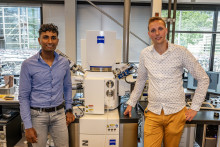Chromatography is a chemical technology that separates molecules from a liquid or blood sample, based on differences in binding to small particles. However, a more ordered particle arrangements could enhance these methods. ‘Our newly developed method gives us full control to arrange dry nanoparticles in any desired pattern’, Ignaas Jimidar, Department of Chemical Engineering VUB (Belgium) and University of Twente, says, while he places a silicon wafer, a 10 centimeter-large shiny reflecting disk, on the lab table. It looks like a CD, and similar to a CD, it holds some invisible secrets. ‘By using lithography, we applied a very thin layer of a soft material in different shapes on top of the disk’, he explains. ‘This layer is more than a 1000-times thinner than a human hair, and this material is more easily charged by static electricity than the wafer material.’
'This layer is more than 1000 times thinner than a human hair'
I’m still a bit puzzled why this matters… But then Jimidar takes a small amount of white powder from a jar, millions of tiny nanoparticles, and puts them on the disk. He takes a small, 1x1 centimeter square of soft plastic and starts rubbing the disk. It doesn’t take long before the hidden secrets on the wafer’s surface start to appear: a jumping horse and the UT Twente logo can clearly be seen. The white particles selectively stick to the electrically charged shapes of lithographed material on top of the disk; they don’t stick to the disk material itself. ‘This is just a demonstration set-up to illustrate our new method: by simply using static electricity, we can control the location of the small particles’, Kai Sotthewes, Department of Physics of Interfaces and Nanomaterials, says. ‘In reality we perform the same techniques on a microscopic scale.’

'Soft materials are loaded more easily than hard materials'
Orderly pattern
Controlling micro- and nanoparticles has been truly challenging, especially for dry powder particles. ‘They easily clump together, because of electrostatic and other surface forces’, Sotthewes, explains. ‘To control and organize dry particles, and make them stick to a surface, the attraction between the surface and the particle has to be stronger than that between the individual particles.’ Since electrostatic forces play an important role in particle attraction and consequent clumping, the scientists used this to their advantage. They tested a combination of two different materials that showed large differences in electrostatic charge. ‘Typically, soft materials, like we lithographed on top of our wafer in our demonstration, are more easily charged compared to the hard wafer materials’, Sotthewes says. ‘As a result, rubbing will result in charging the soft material only, and the particles will stick in an orderly pattern to the soft material shape. Using this relatively simple principle, we can now manipulate these particles in every desired shape.’
Improve chemical assays
The application of the new method goes far beyond creating nice shapes on a surface. The possibility to develop highly improved assays and separation methods used in chemistry, for example in chromatography, is particularly relevant. This standard chemical separation technique is based on the principle that different chemicals stick in various degrees to small particles. ‘Many people have seen how a dot of black ink can be split into many different colors, by applying it on a plate, coated with a layer of small particles’, Jimidar explains. ‘By subsequently running a solvent through this particle layer, the black ink is separated into different colors, because the different dyes have a different stickiness to the particles.’
'Many people have seen how a dot of black ink can be split into many different colors'
But although this so-called ‘thin-layer chromatography’ has been around for a long time, it still has limitations. For example, when applying different samples for separation, there needs to be enough space between them, to avoid mixing, limiting capacity. Also, the particle layer is relatively thick, and thus requires a large sample volume. Jimidar: ‘Organizing and controlling particles gives us the possibility to apply a much thinner layer on the plate, just 10, instead of 200 micrometers, while we can organize them in narrow bands. We can now apply a much smaller sample, increasing the assay’s sensitivity and accuracy. But the narrow bands of particles also allow us to run more samples on the same plate.’ So, by being able to control particles and manipulate them in a more orderly way, the scientists have made it possible to massively improve this assay.

Different stickiness
Another important application of controlled particles is in liquid chromatography (LC), which uses the same separation principle as thin-layer chromatography: different chemicals have a different stickiness to particles, that are packed in a tube-shaped column. Through this column runs a fluid, containing the chemical mixture to be separated. The compounds that stick the most to the column particles will come out last, while the ones sticking the least, will come out first. This results in a separation of different chemicals. However, also the particles inside the column suffer from ‘particle chaos’, resulting in efficiency and accuracy losses. It is estimated that about 50–60% of their separation potential is lost, due to the random nature of particle packing. ‘We have found that if you pack the column particles in a more organized way, by applying our method using electrostatic forces, the separation becomes much better’, Jimidar says. ‘A well-organized particle distribution results in a less chaotic fluid flow, that moves more as a straight front through the column. This results in a much better separation of the chemical mixture as well as a higher sensitivity.’
Also bioassays and optical sensing to detect proteins (proteomics), operating at a microscopic scale, will benefit from the application of ordered particles. ‘We can apply a very thin layer of ordered particles on a small chip’, Jimidars says. ‘Due to the organized particle pattern, the fluid running through is much smoother and doesn’t suffer from flow dispersion. This in particular increases both efficiency and accuracy and may lead to the early detection of proteins associated with for example cancer or Alzheimer’s disease.’
Although making a thin, ordered particle layer has finally been achieved, it may take another few years before the method can be implemented in chemical assays. Jimidar: ‘Since chromatography particles are often porous, to increase its surface area, and are specifically coated for selected separations, we need to modify and test our method to order these particles too.







